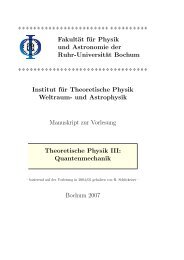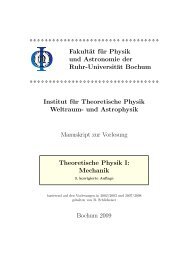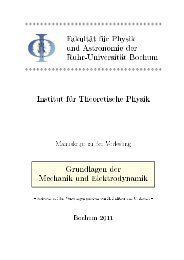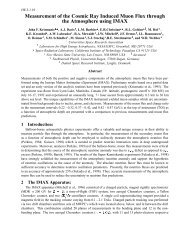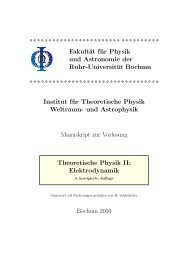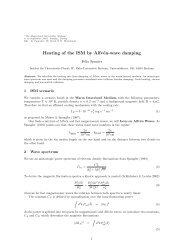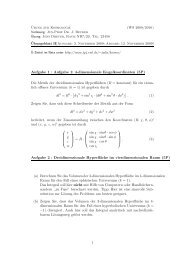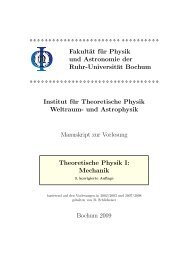pdf here - Theoretische Physik IV - Ruhr-Universität Bochum
pdf here - Theoretische Physik IV - Ruhr-Universität Bochum
pdf here - Theoretische Physik IV - Ruhr-Universität Bochum
You also want an ePaper? Increase the reach of your titles
YUMPU automatically turns print PDFs into web optimized ePapers that Google loves.
Increasing and i would lead to a decrease of the amplitude but the width would increase<br />
slightly. Figure 10 represents the electrostatic potential, as expressed by Eqs.<br />
(35), (36) and (42), depicted in three-dimensional plots versus the radial coordinate<br />
r and the polar angle :It is clear that the propagation of both positive<br />
and negative soliton pulses as well as the shock waves being slightly distorted<br />
with polar angle.<br />
VI.<br />
SUMMARY<br />
In this paper, we have studied the nonlinear propagation of electron-acoustic waves in<br />
an electron-positron-ion plasma .<br />
A background of thermalized ions was considered as<br />
a hypothesis that occurs in accretion disks of AGN. By adopting a cylindrical geometry,<br />
we have derived a cylindrical Kadomtsev-Petviashvili equation, which yields exact soliton<br />
solutions in the form of positive or negative potential pulse excitations.<br />
Furthermore, we have also considered situations in which the strength of the nonlinearity<br />
is weak, so that higher-order nonlinearity may play an important role. We have derived an<br />
extended cylindrical Kadomtsev-Petviashvili (ECKP) equation, modelling the potential evolution<br />
in this case. Exact solutions of ECKP equation were derived, in the form of localized<br />
pulses (which were compared to the CKP pulses obtained previously) and double layers, i.e.,<br />
propagating localized transition forms (double layers) among regions of constant potential.<br />
A set of exact expressions was presented for these localized potential perturbations, and<br />
their characteristics were investigated.<br />
The nonlinear structures derived in this study owe their existence to a balance among the<br />
dispersion and nonlinearity, and were obtained in a 2D cylindrical geometry (in radial and<br />
angular polar coordinates), thus representing structures propagating in the radial direction<br />
while being slightly distorted and accelerated due to angular, i.e., (weak) non-gyrotropic<br />
e¤ects. Anticipating a more general theoretical scope, it may be pointed out that, from a<br />
qualitative point of view, the various scaling assumptions employed <strong>here</strong> amount to the form<br />
' (1) = ' (1) (R) for the localized excitation (solitons, double layers), w<strong>here</strong> R is the moving<br />
frame de…ned by:<br />
R = " 1=2 r<br />
+ "U 0 + <br />
2 2 t : (45)<br />
Here, is the (main radial) propagation speed, corrected by U 0 , while an angular dependence<br />
14



